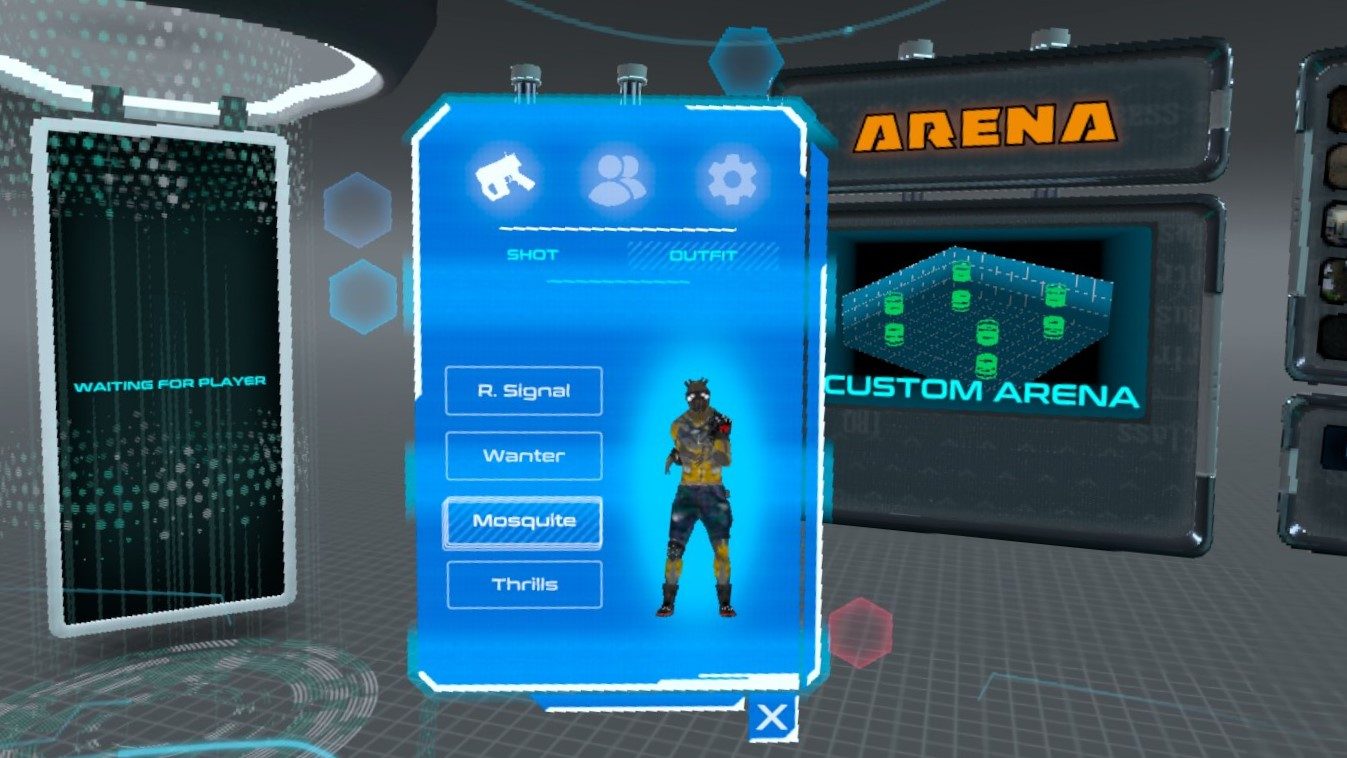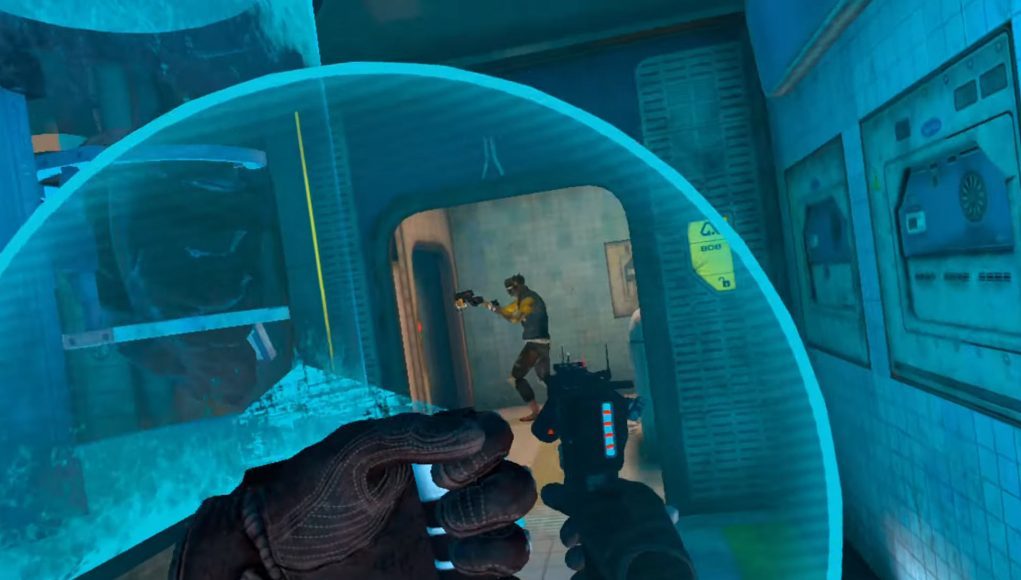Space Pirate Trainer (2017) on Oculus Quest received a substantial update last week, which brings to the wave-based shooter two new multiplayer modes, one of which basically turns your Quest into a mobile laser tag machine for some 1v1 multiplayer action. Just like the base game, the new additions are well-polished, although the large-format Arena mode comes with a fair bit of friction that may limit these sorts of experiences from taking off before VR headsets are more widespread.
Note: Space Pirate Trainer DX is a free update for people who own Space Pirate Trainer on Quest prior its September 9th launch. The game on Quest is now priced at $25. The classic Space Pirate Trainer remains available on Steam, Oculus Rift, PlayStation and Microsoft stores for $15.
Before the update’s release on September 9th, Space Pirate Trainer on Quest was a single-player wave shooter that boasted extremely high polish. It’s one of those basic experiences everyone should have at least once in VR since it’s so easy to pick up for newcomers and so difficult to put down.
The game, now named Space Pirate Trainer DX on Quest, includes two new modes: Versus, a multiplayer version of the classic solo mode, and Arena, which offers up a few large-format maps for a 1v1 shootout that you might typically find at a VR arcade.
Arena: Star of the Show
I’ll go into all of the necessary safety precautions and caveats below—please don’t miss that—but first a bit on gameplay.
Arena literally uses the entire allowable Guardian space on Quest, a full 10 × 10m (33 × 33ft) space, and there’s no side-skirting that. Over the course of a few days I visited an outdoor basketball court with a local Quest-owning friend so I could bite into both single and multiplayer modes within Arena, which offers up five maps where you can either go head-to-head with another player, or go against waves of increasingly difficult bots.
Simply put: Arena is fun, tiring, and really worth your time if you can organize a match. If.
Unlike the standard single-player mode in SPT, in Arena you’re given a single pistol with infinite ammo and a hand-held shield that can only be activated for a short amount of time. The pistol can either shoot in semi-auto, or with a single charge shot that bounces around everywhere. Keen users of the charge shot can bend bullets around corners and secure a hit, although I never did.
Each player has three lives and no health bar, so getting hit once will force you to respawn in one of four specific zones within a set amount of time, otherwise it will slowly count down and take yet more lives from your bank of three. Arena keeps track of what zones you can respawn at so you’re not spamming a single spot.
Just like the classic wave-based mode, Arena’s bot-mode serves up increasingly difficult waves of baddies which eventually overwhelm you. Bot-mode is fun, and makes for a bitesize way to enjoy Arena before you can setup a proper match, although I’m not sure I would go through the trouble of securing a suitable space just to play Arena’s single-player in the future since it doesn’t offer nearly the same gameplay depth of the classic single-player mode.
As you’d imagine, the 1v1 mode is where Arena truly shines, as it essentially presents a miniature version of laser tag, playable both online in separate spaces over the internet, or locally by using either existent WiFi or a WiFi hotspot on your phone.
To play in the same physical space you’ll need to calibrate accordingly, which takes some finessing the first few times. The best way to do that is to stand approximately in the middle of the playarea and place a piece of tape. Configure that as you center point by facing that direction and hold the ‘Oculus’ button to recalibrate the game’s orientation. From there, you should be safe to play in the same court.
YouTuber ‘VR Oasis’ does a much better job than me at showing off just how it all works on camera in this head-to-head local match.
Space Pirate Arena is dropping today on Oculus Quest / Quest 2 as part of the free Space Pirate Trainer DX update from @i_illusions! 🥳
It feels good to be back on my feet after surgery and making videos again. I have an overview and setup guide video coming later today 👀 pic.twitter.com/aYg6xwfGwM
— Mike – VRO (@vr_oasis) September 9, 2021
Notably, Arena doesn’t feature a match-making function, so you’ll need to find games manually, either by securing some 1v1 time with a friend or by trawling Discord servers for random people. Even if it did have match-making, you’d probably never find a game. More on that later.
If you’re looking to spend some time between matches, one really neat function is the level builder tool, which lets you place blocks of variable sizes in the full playspace and change around the positioning of the spawn points.
In all, the measure of immersion thanks to 1:1 physical movement really makes Arena feel like a premium experience you might well pay for at a mall or VR arcade.
Gameplay left me with very few actual gripes. Maps are fairly samey, and really only act as slightly different spaces to run and hide around. I was really hoping for a little more complexity to both maps and the general “straight shootout” nature of the game, although the pure novelty of it being able to replicate the feeling of a more premium experience was pretty cool on its own. It’s truly got just enough going on right now to make me want to share it with friends.
In the end, I understand why the team didn’t include artificial locomotion like teleporting and smooth stick motion, but I still can’t help but think the game would benefit from offering a hybrid model, where users in arena-scale spaces can play against people in more cramped areas. That would certainly make finding a quick pickup game easier.
High Barrier of Entry
Developers I-Illusions call their Arena mode “a glimpse at the future of VR,” and I think that’s the right way to couch it. It certainly isn’t the ‘now of VR’—and not just because it requires a massive 33 × 33ft (10 × 10m) playspace, or about the size of half a basketball or tennis court. You’re thinking, “I know just the place down the road that will work great,” but there are some caveats to contend with here which we can almost entirely chalk up to the Quest’s hardware.
The developers suggest playing indoors, although that presents its own hurdles when you aren’t a member of a gym or have free access to a large enough indoor area at a moment’s notice. I live in a pretty typical city apartment and I don’t have access to those sort of spaces without paying for it, so I searched out a space nearby my house that seemed to work okay. Yes, I looked like a total dork in the public park, but stepping into the game’s new otherworldly shooting arenas soon insulated me from any possible outside judgement.

It’s important to note that outdoor play is dicey on Quest, as the headset’s positional tracking doesn’t fare well in either direct sun or low lighting conditions. If you want to play outside, you’ll typically need to play at dawn, dusk, or when it’s shady enough to establish a rock-solid Guardian. Simply put, going out in full sun is basically a no-go, and playing at night with adjacent street lights can be equally unfeasible if they aren’t bright enough. You’ll also need to make sure people aren’t going to run into your invisible play area, something bystanders might do since there’s no clear indication that you’re about to make a blind dash for cover behind an invisible wall three meters away.
The amount of clear intention required to play Arena sets a high barrier to overcome for such a small addressable population of players, although that may not always be true. As VR headsets become yet more diffuse, one day it may be entirely normal for people to bring their own headsets to the gym to play an even grander arena-scale games. The difficulty of not being able to play outside in full sunlight might also be a non-issue as companies prioritize the hardware for outdoor play compatibility, making every park a place where you might run around and battle against friends or strangers.







